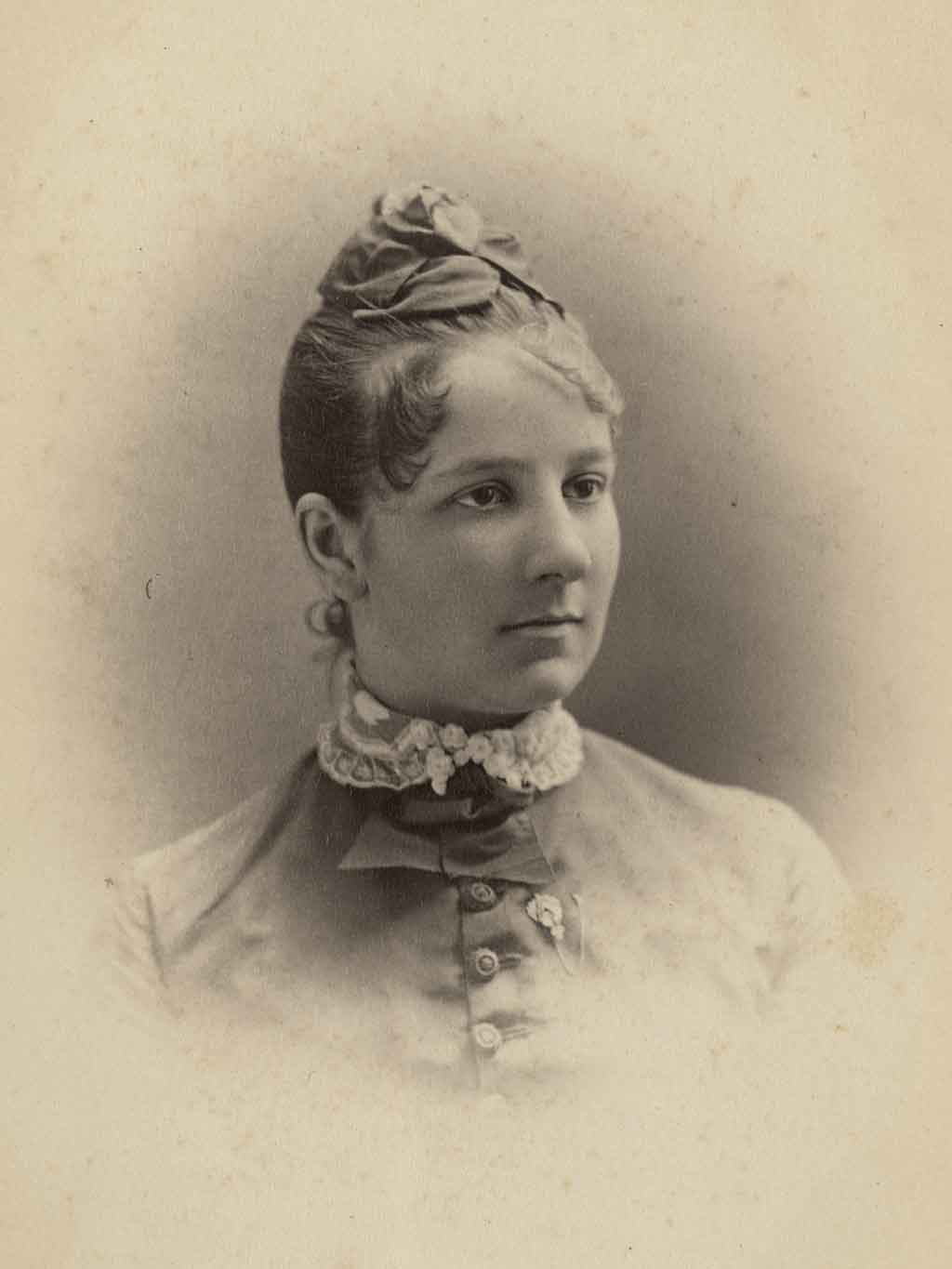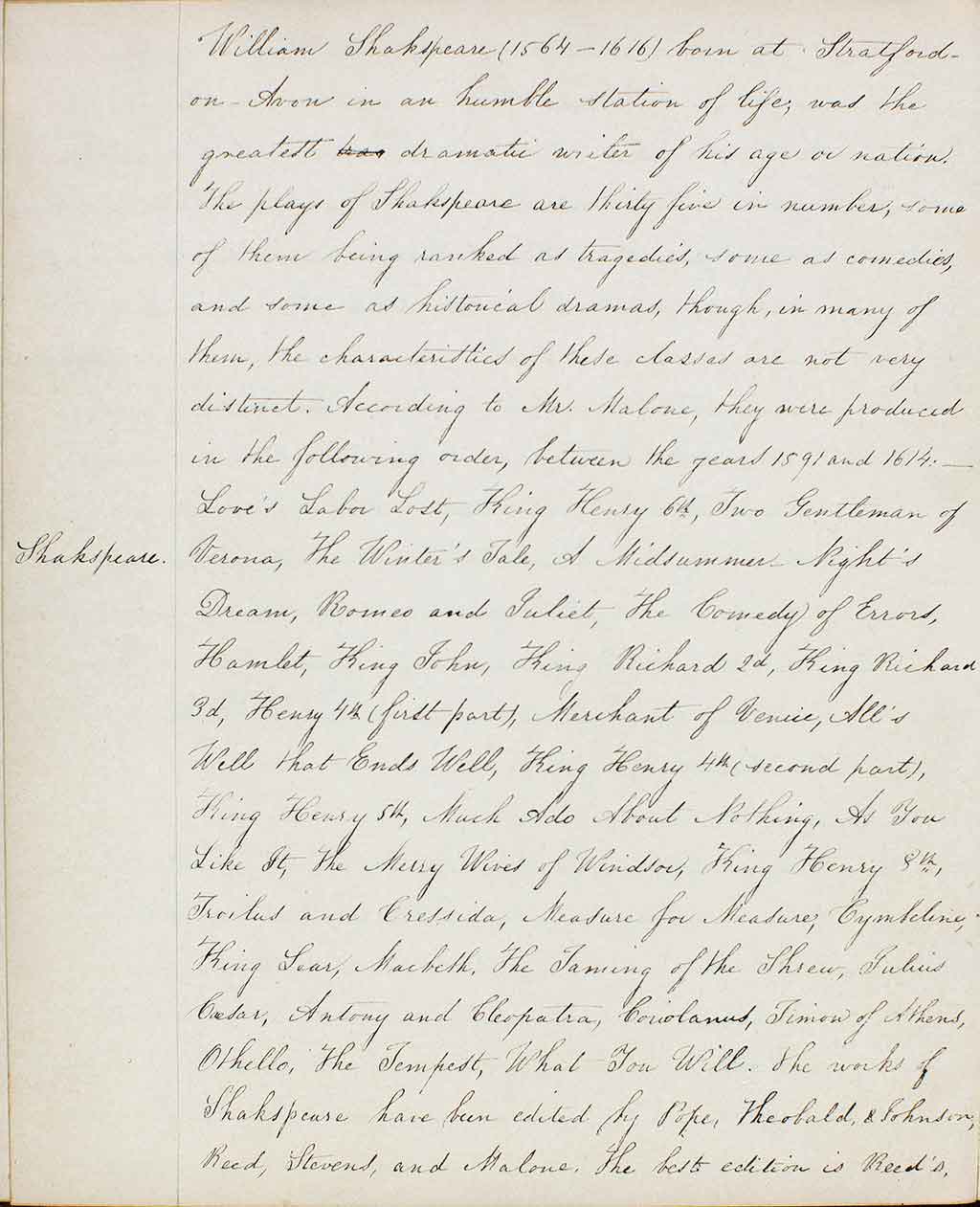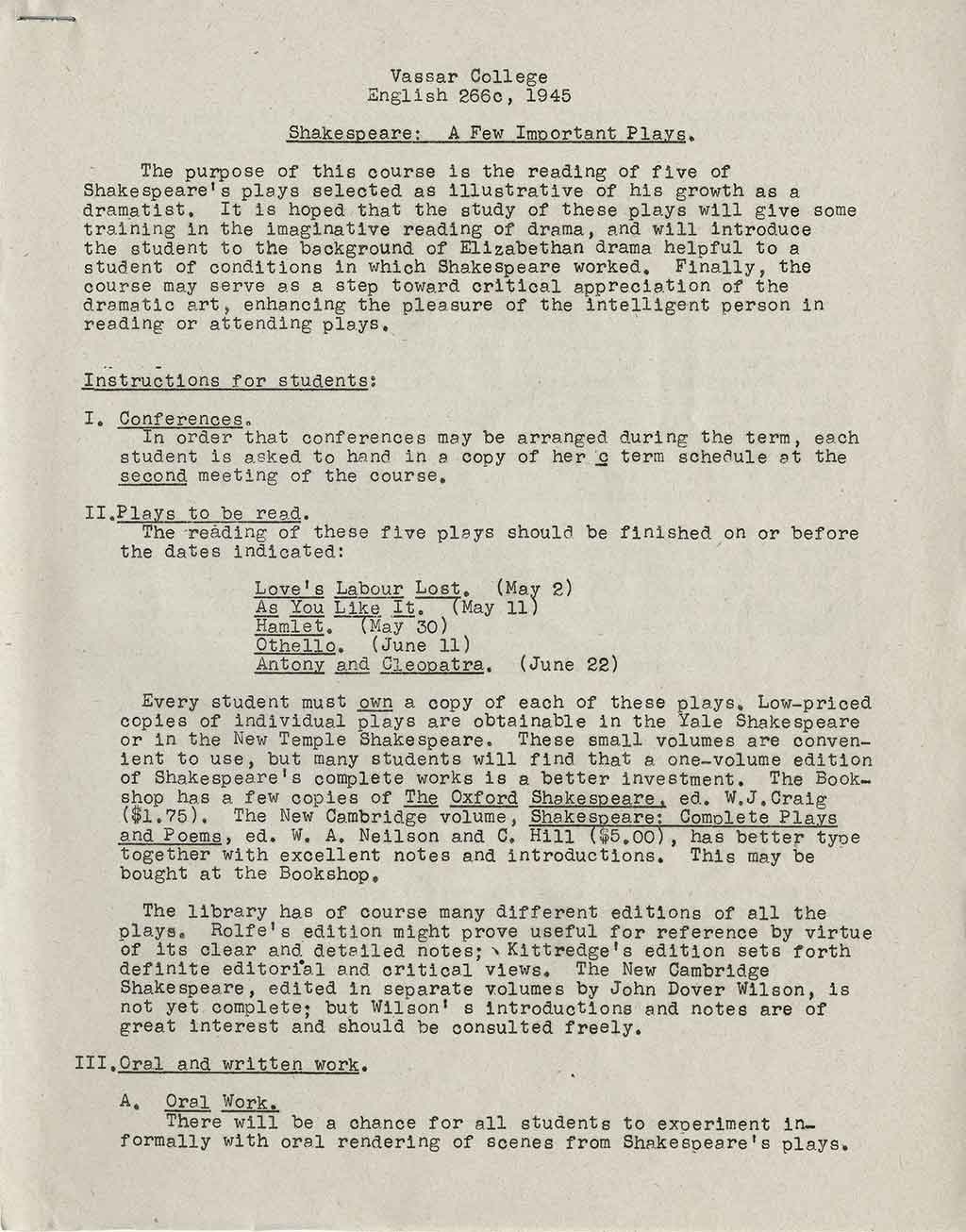Shakespeare at Vassar
Teaching Shakespeare at Vassar 1
by Zoltán Márkus
Associate Professor of English
“Among teachers of English literature, there is a growing conviction,” claimed Truman J. Backus in his “Preface” to Shaw’s New History of English Literature in 1874, “that much time is wasted in the classroom by attempting to learn about too many authors. Such an attempt is dissipating to the mind of the student, and is most unsatisfactory to the teacher.”2 Instead, Professor Backus recommended the study of a select few authors (especially, that of Chaucer, Spenser, Shakespeare, Bacon, Milton, Dryden, Pope, Swift, Addison, Johnson, Goldsmith, Burns, Scott, and Byron). Shakespeare deserved particular attention since his works “show such stores of knowledge, such powers of discrimination, such rescues of wit, such pathos, such exhaustlessness of language, such scope of imagination, as can be found in no other English poet.”3
Truman J. Backus was Professor of Rhetoric, Belles-Lettres, and the English Language at Vassar between 1866 and 1883; he organized his teaching into four divisions: Rhetoric, Logic, Elocution, and English Literature.4 For the study of literary history, he used Shaw’s New History of English Literature, which he thoroughly revised and updated. As he put it in his Preface to the Second Edition (1884), “In the revision of this work, my recent assistants in the Department of English Literature at Vassar College have placed me under obligation for most valuable help in matters demanding careful and scholarly research.”5 During the first two decades of Vassar’s history, students studied Shakespeare with the aid of Chapter IX of Shaw’s New History of English Literature. The main topics of this chapter on Shakespeare were the following: “1. His Career as a Dramatist. 2. His Early Non-Dramatic Poems. 3. Classification of His Plays. 4. His Comprehension of Nature. 5. His Delineation of Character. 6. The Origin of His Plots. 7. His Metaphorical Style. 8. His Influence in the History of our Language. 9. His Sonnets.”6
Backus’s successor, Manuel J. Drennan (Professor of Rhetoric and of the English Language and Literature, 1883-1894) took heed of Backus’s suggestion that students should study a limited canon of a dozen or so influential authors to develop a foundation for their understanding of literary history. In addition, however, Professor Drennan also introduced a new course that was first devoted to “The Elizabethan Era” and, later, to “Shakspere”:
During the first semester of the Senior year there is a Shakspere course of two hours. The purpose of this course is to give an introduction to the various lines of Shakspere study, historical, literary, philological. A single play—this year, Richard II.—is thoroughly mastered, and the student is then assisted to draw out analytically the laws of dramatic poetry. A few other plays, if possible one of each class, are similarly treated.7
Under Professor Drennan’s guidance, the instruction of English had three fields (they called them “departments” then): Rhetoric and Composition, English Literature, and Anglo-Saxon. Freshmen and sophomores had their courses prescribed, whereas juniors and seniors were able to enroll in elective courses. During sophomore year, students had to take a survey course on English literature beginning with Wycliffe. The elective courses included “Course D,” devoted to “Shakspere, Laws of Dramatic Composition.” The model of a required survey course and the elective study of Shakespeare was established at the end of the 19th century and remained in the curriculum of the English Department for a long time.
Another tradition that started in the 19th century and has survived even today is the Helen Kate Furness essay competition. The earliest record of this prize I have found is from the 1884-85 College Catalogue. Helen Kate (Rogers) Furness, an excellent scholar of Shakespeare (and wife of Horace Howard Furness), passed away in 1883; the Prize established in her honor immediately after her death has been a laudable commemoration of her work ever since. (There is a Helen Kate Furness Prize at Smith College as well.) The first description of this Prize states that,
THE HELEN KATE FURNESS PRIZE FUND
furnishes annually two prizes, one of thirty and one of twenty dollars, which are granted to the writers of the two best essays on some “Shakespearian or Elizabethan subject,” competition being open to all members of the Senior Class. The subject is assigned a year in advance, and essays must be presented at the opening of the second semester. The subject for the year 1885-86 will be, The Will as illustrated in Shakespeare’s Characters.8
Later topics assigned for the Furness Prize included “Shakespeare’s Delineation of Women as Compared with that of Thackeray” (1886-87); “Shakespeare’s Delineation of the Workings of Conscience” (1887-88); “The Influence of the Miracle Plays upon the Shakespearian Drama” (1888-89); “Shakespeare’s Representation of the Celtic Character” (1890-91); and “Some Uses of Shakespeare to the Modern Reader” (1910-11). Today, the Furness Prize is open to members of all classes; it awards only one prize, and that comes without any monetary bonus.

A pedagogical tradition that has not survived since the 19th century is the practice of awarding Master’s degrees at Vassar. The early leadership of the College recognized that the graduating women had only limited options for continuing their studies at the graduate level and so made it possible for deserving students to pursue their studies further at Vassar. Working together with Vassar faculty members, students had to develop individual study programs (either in residence for one year or in absentia for two), pass examinations in the selected courses, and present an acceptable thesis. Vassar College awarded its first Master’s degree in 1869; during the following decade, another dozen students received a “Second Degree in Arts (A.M.),” and the number of awardees further increased by the end of the century. One of the more distinguished candidates, Emily Jordan Folger, class of 1879, co-founder of the Folger Shakespeare Library in Washington D.C. (and wife of Henry Clay Folger, Jr.) earned her Master’s in 1896 (Figure 1). Her thesis, “The True Text of Shakespeare,” posits and demonstrates two important arguments: 1) The First Folio (1623) of Shakespeare’s plays is “the edition of authority” that later editors need to follow; 2) The First Folio is “not Shakespeare” on account of various mediating factors. Although the tone of the thesis is highly deferential to Shakespeare experts (and, most of all, to her thesis advisor, Professor Horace Howard Furness), the intellectual stakes of the thesis are clearly defined at the very beginning, as she argues for the “Appropriateness of study of verbal criticism of Shakespeare by an American-speaking woman.”9 When she was invited to give a talk on the 50th anniversary of the College in 1915, Emily Jordan Folger, as “an American-speaking woman” and a fine expert of Shakespeare, made a powerful presentation on “Some Women Interpreters of Shakespeare,” with which she, as an article in 1990 put it, “threw down a feminist gauntlet.”10
Laura Johnson Wylie, class of 1877 (another student of Professor Backus) “threw down a feminist gauntlet” as well, when she became one of the first female graduate students at Yale, received her Ph.D. there in 1894, started teaching at Vassar in 1895, and became the first female Chair of the English Department in 1897 (Figure 2). She worked as Chair for over twenty years, during which time new courses on Shakespeare and English drama were introduced. The English Department started offering fewer required courses (mainly Expository Writing) and more elective ones. In 1910-11, along with the course on “Development of English Literature from Beowulf to Johnson,” students were able to elect courses such as Courses L and LL: “Shakespeare” (“Critical reading of a few plays, with special emphasis on dramatic technique, followed by careful reading of a number of plays as illustrating the development of Shakespeare’s dramatic art and his place in Elizabethan drama.”), Courses M and MM: “The development of the English Drama from the Miracle Play to the present time,” Courses N and NN: “Shakespeare” (“Lectures on the historical setting for the content and form of Shakespeare’s plays.”), Courses O and OO: “History of Shakespeare criticism from 1592 to the present time.”11 Most of the Shakespeare courses were taught by Associate Professor Florence V. Keys (1900-1914).

In 1911, a former Vassar student and recent PhD from Columbia, Winifred Smith, was hired by Laura Johnson Wylie as an Instructor of English. Four years later, Henry Noble MacCracken, a professor of English and Drama, became the 5th president of Vassar College. These two appointments significantly influenced the study of Shakespeare—as well as many other aspects of college life. Professor Smith, who became Assistant Professor in 1916, Associate Professor in 1922, Professor in 1926, and Chair in 1929, emphasized that plays were created, first and foremost, to be performed. “Here was a woman,” Vassar Encyclopedia quotes Drama professor Evert Sprinchorn, “who knew that dramatic literature could not be fully understood and appreciated unless it was seen in its physical aspect and not simply as disembodied words. Drama could not be separated from theater.”12 This recognition, already embraced by Professor Gertrude Buck’s experimental courses in dramatic writing and performance in the 1910s, shaped Winifred Smith’s “Development of the English Drama” courses in the 1920s. The realization that the primary form of dramatic works is not the printed text but the staged performance motivated the appointment of Hallie Flanagan as Associate Professor of English in 1925 as well as Professor and Director of the Experimental Theater in 1929. This recognition, moreover, led to the creation of the new subject “Drama” at Vassar in 1938. Winifred Smith, as Professor of Drama, was appointed to chair the new department. It is significant, although hardly surprising, that courses in Drama did not focus on Shakespeare: the Bard remained under the aegis of the English Department.
President MacCracken, who had been a Professor of Dramatic Literature at Smith College prior to his appointment as President of Vassar, supported these new developments. By cross-listing courses between Drama and English (and Comparative Literature), he made sure that as many students as possible would benefit from the new arrangements. In general, he created more flexible educational structures (fields and subjects) and a more informal, encouraging learning environment. Within the English Department, he approved of the course structure of four levels: 100-level: Introductory; 200-level: Intermediate; 300-level: Advanced; and 400-level: Seminars for Seniors. In 1938/39, for example, a course on “Periods of English Literature” was offered at the Introductory level (130: “An introductory course in the historical study of literature. Reading of poetry, drama, and prose from the middle ages to the eighteenth century. Practice in writing.”) and a similar one on “English Literature to the Close of the Eighteenth Century” (230: “The history of English literature from its beginnings to the death of Johnson. Reading of significant works that indicate the general characteristics of thought and form as they express the spirit of the times.”). More defined surveys at the Intermediary level included 239: “English Literature in the Seventeenth Century,” 255: “English Drama,” and 265: “Shakespeare.” The senior seminars included 455: “Studies in Drama” and 463: “Studies in the English Renaissance.”13 This course structure—with minimal tweaking—survived well into the postwar period as well.
During the 1930s and 1940s, Shakespeare was primarily taught by President MacCracken and Helen Estabrook Sandison (1913-1950), who was also Chair of English. In 1945, a summer semester (term “c”) was introduced, during which President MacCracken taught English 266c: “Shakespeare: A Few Important Plays.” They read five plays: Love’s Labour’s Lost, As You Like It, Hamlet, Othello, and Antony and Cleopatra. President MacCracken described the main objectives of the 200-level Shakespeare course as the following:
The purpose of this course is the reading of five of Shakespeare’s plays selected as illustrative of his growth as a dramatist. It is hoped that the study of these plays will give some training in the imaginative reading of drama, and will introduce the student to the background of Elizabethan drama helpful to a student of conditions in which Shakespeare worked. Finally, the course may serve as a step toward critical appreciation of the dramatic art, enhancing the pleasure of the intelligent person in reading or attending plays.14
Apart from the somewhat cumbersome style, the main goals of this class were shared by later Shakespeare courses as well (Figure 3).

In the second half of the twentieth century, courses on Shakespeare and English Drama followed the curricular structures developed by the 1930s. Introductory level 130ab: “Periods of English Literature” survived until the late 1970s; a version of intermediate-level 230ab: “English Literature to the Close of the Eighteenth Century” exists even today. Various incarnations of the advanced level 367ab have existed from the mid-20th century through today: they have been called “Literature under Elizabeth and the Early Stuarts,” “Literature under Elizabeth,” “Non-Dramatic Literature of the English Renaissance,” and—more recently—“Studies in the Renaissance.” Multiple groups of 265ab: “Shakespeare” were offered in the course of the twentieth century; by the late 1970s, the yearlong Shakespeare courses had been complemented with semester-long Shakespeare classes as well. At the more advanced level, however, there were no courses on Shakespeare. To rectify this, Professors Harriett Hawkins and Everett K. Weedin, Jr. started offering 300-level courses in the early 1980s in the experimental curricular rubric of “Special Studies in Language, Writing, or Literature.” In addition to Professors Hawkins and Weedin, Jane Jenkinson Swenarton, Richard A. E. Brooks, M. Jeane Humphreys, Lynn Conant Bartlett, Dean Tolle Mace, William W. Gifford, Julia McGrew, Ann E. Imbrie, and Eamon Grennan were some of the most memorable Shakespeare professors at Vassar in the second half of the twentieth century.
NOTES
1 I thank Ronald Patkus for his leadership and support in this endeavor as well as my research assistant, Lily Elbaum, for her help in conducting research for this article.
2 Truman J. Backus, “Preface to the First Edition,” Shaw’s New History of English Literature (New York: Sheldon and Company, 1887), x-xi.
3 Shaw’s New History of English Literature, 114-5.
4 About Backus and the history of Vassar’s English Department, see Violet Edelman, “The History of English at Vassar College,” http://150.vassar.edu/histories/english/. A more detailed version of this article, “The History of the Vassar College English Department: Beginnings-Present,” is also available: http://150.vassar.edu/histories/english/english_dept_history_long.pdf.
5 Truman J. Backus, “Preface to the Second Edition,” Shaw’s New History of English Literature, xiii.
6 Shaw’s New History of English Literature, 115.
7 Twenty-Fourth Annual Catalogue of the Officers and Students of Vassar College, Poughkeepsie, NY, 1888-89, 28.
8 Twentieth Annual Catalogue of the Officers and Students of Vassar College, Poughkeepsie, NY, 1884-85, 37.
9 Emily C. J. Folger, “The True Text of Shakespeare,” Thesis in application for the degree of Master of Arts, Vassar College, 1896. Emily Jordan Folger, Box 88.
10 Elizabeth Sussman Socolow, “Found: Some Women Interpreters of Shakespeare in Vassar’s Folger Collection,” Vassar Quarterly (Spring 1990): 18 and 21.
11 The Forty-Sixth Annual Catalogue of Vassar College[,] Poughkeepsie, NY[,] 1910-11, 70-1.
12 “Winifred Smith,” Vassar Encyclopedia, https://vcencyclopedia.vassar.edu/faculty/prominent-faculty/winifred-smith.html.
13 Bulletin of Vassar College: Catalogue Issue 1938-39, 85-90.
14 Henry Noble MacCracken’s “English 266c, 1945” Course Description. MacCracken Folder 77.21.